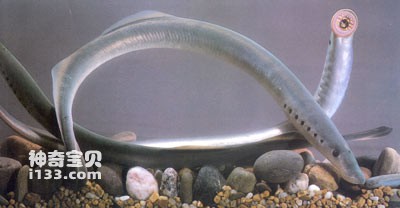The Japanese lamprey (Lampetra japonica) belongs to the family Cirostomata, order Lamprey, family Lampeidae, and genus Lamprey. Commonly known as: lamprey, seven-star fish. English name: Arctic lamprey.
Endangerment level: Vulnerable.
The body is cylindrical and the tail is flattened laterally. There are a row of 7 separate gill openings behind the eyes on each side of the head. The gill openings are aligned with the eyes, with a total of 8 eye-like points, so they are commonly known as eight-eyed gills. The nostril is single, located in the middle of the two eyes on the back of the head; there is a white skin spot behind the nostril, which is photosensitive skin. There is a funnel-shaped suction cup on the front and ventral surface of the head, which is round when open. There are many soft papillae protrusions on the surrounding wrinkled skin. The mouth is at the bottom of the funnel. There are many yellow horny teeth on both sides of the mouth. There is a fleshy, tongue-shaped piston in the mouth, and there are also horny teeth on it. The skin is soft, smooth, scale-free, and the lateral lines are underdeveloped. No pectoral and pelvic fins. There are two dorsal fins, which are approximately equal in length. The dorsal fin at the back is connected to the caudal fin, and the fin rays are soft and dense. When alive, the back is cyan with green, the abdomen is grayish white with a slight yellowish color, and the edges of the tail fin and back dorsal fin are black.

Lamprey is a typical migratory fish and lives part of the time in the sea. In autumn, it enters rivers from the sea and overwinters in the lower reaches of rivers. From May to June of the following year, when the water temperature reaches about 15°C, it goes back to the upper reaches to breed. Lampreys choose shallow, fast-flowing, gravel-bottomed waters to dig holes to build nests and lay eggs. The male fish sucks the female's head with a suction cup while ovulating and fertilizing. The eggs are extremely small, with 80,000 to 100,000 eggs laid each time. The eggs are stuck to the gravel in the nest. All brood fish died after spawning. Soon after the eggs hatch, they become young eels. Young eels live in the mud and sand, hiding under the mud and sand during the day and coming out to feed at night. The larvae at this stage are very different from the adult fish. The mouth suckers are underdeveloped and triangular in shape. They are called sand hidden juveniles and live a free life. The lifespan of a lamprey is about 7 years. After living in the river for 4 years, the juvenile fish metamorphoses and goes to the sea in the fifth year. After living in the sea water for 2 years, it goes up the river to spawn and migrate.
Lampreys are carnivorous fish. It lives an independent life as well as a parasitic life. It often uses suckers to attach to other fish bodies, and uses the horny teeth in the suckers and tongue to break the fish bodies and suck their blood and meat. Sometimes only the skeleton of the fish that is sucked is left in the end. When living independently, they feed on zooplankton. The larvae feed on humus debris and filamentous algae. Adult fish during the reproductive period stop eating.
Lampreys are distributed in various rivers in Northeast China. In addition to the larger size of this species, there are two other species of terrestrial lampreys, namely the Northeastern lamprey (L.morii, English name: Yalu River Lamprey) and the creek lamprey (L.reissneri, English name: Asiatic brook lamprey), but the individuals are small, live in rivers throughout their lives, have no migratory habits, and are very few in number, so they are all in a vulnerable situation.
Adult lampreys can reach over 60 centimeters in size and weigh about 0.25 kilograms, and are edible. It contains high fat content and is a valuable edible fish. Fish also contains befaine, creafine, etc. In addition, the contents of protein and vitamins A and D are relatively high. Lamprey bodies can be used as medicine. The medicinal property is sweet and warm, and has the effect of nourishing and strengthening the body; it is often used to treat mouth and eye deviation, night blindness, dry cornea and other diseases.
The resources of Japanese lamprey are quite small and are in a vulnerable state. The main reason for the danger is that due to the impact of soil erosion, the spawning grounds and the living environment of young fish have been destroyed, and water pollution has affected the living environment. There are currently no effective protective measures.
animal tags:
We created this article in conjunction with AI technology, then made sure it was fact-checked and edited by a Animals Top editor.